Developing On-Road NOx Emission Factors for Euro 6b Light-Duty Diesel Trucks in Korean Driving Conditions
Abstract
1. Introduction
2. Materials and Methods
2.1. Test Vehicles
2.2. Laboratory Tests
2.3. Real Driving Emissions Tests
2.4. Data Analysis
3. Results and Discussion
3.1. Comparisons of NOx Emissions from Real Driving Emissions (RDE) and Laboratory Tests
3.2. Comparisons of NOx Emissions from RDE and Laboratory Tests Based on Average Vehicle Speed
3.3. Examining the Difference in NOx Emissions in Results from RDE and Laboratory Tests
3.3.1. Influence of Driving Dynamics
3.3.2. Influence of NOx Emission Control System
3.4. Validation of On-Road NOx Emission Factors
4. Conclusions
- The average on-road NOx emissions of the Euro 6b LDDTs were 4.4–14.6 times higher than those measured with the NEDC, an emission certification test cycle. The NOx levels were also 2.1–6.9 times higher on average than those measured with the KDC, a conventional test procedure used to develop emission factors in Korea;
- The KDC can be considered to represent typical driving patterns in Korea; however, it fails to cover a wide range of average vehicle speeds and RPA in real driving conditions. In particular, the KDC had limitations in terms of capturing excessive NOx emissions observed under driving conditions when the RPA was high;
- The NOx storage and de-NOx regeneration in LNT technology, adopted as part of NOx after-treatment equipment used for Euro 6b LDDTs in Korea, performed well under the NEDC, but insufficiently, in terms of achieving low NOx emissions levels, in real driving conditions;
- The NOx emission factors according to average vehicle speed, developed in this study via RDE tests, were comparable to those suggested in COPERT 4, thereby showing a remarkable difference from the NOx emission factors developed through conventional laboratory emission tests. Therefore, realistic NOx emission factors for Euro 6b LDDTs in Korea should be based on emission factors developed from data measured in real driving conditions.
Author Contributions
Funding
Institutional Review Board Statement
Acknowledgments
Conflicts of Interest
Abbreviation
| CAPSS | Clean Air Policy Support System |
| NOx | Nitrogen oxides |
| LDDTs | Light-duty diesel trucks |
| PEMS | Portable emissions measurement system |
| NEDC | New European driving cycle |
| LNT | Lean-NOx trap |
| SCR | Selective catalytic reduction |
| EGR | Exhaust gas recirculation |
| DPF | Diesel particulate filter |
| WLTC | Worldwide harmonized light-duty test cycle |
| KDC | Korean driving cycle |
| DOC | Diesel oxidation catalyst |
| RDE-LDV | Real driving emissions of light-duty vehicles |
| MAW | Moving averaging window |
| DEAR | Data manager for emission rates and activities of road transport |
| RPA | Relative positive acceleration |
| COPERT | Computer programme to calculate emissions from road transport |
References
- Yao, Z.; Wu, B.; Wu, Y.; Cao, X.; Jiang, X. Comparison of NOx emissions from China III and China IV in-use diesel trucks based on on-road measurements. Atmos. Environ. 2015, 123, 1–8. [Google Scholar] [CrossRef]
- Clean Air Policy Support System (CAPSS). National Air Pollutant Emission Report 2016. Available online: http://airemiss.nier.go.kr/mbshome/mbs/airemiss/index.do (accessed on 29 December 2020). (In Korean)
- Korea Automobile Manufacturers Association (KAMA). Vehicle Registration Statistics 2016. Available online: http://www.kama.or.kr/NewsController?cmd=V&boardmaster_id=Register&board_id=390&menunum=0003&searchGubun=&searchValue=&pagenum=5 (accessed on 29 December 2020). (In Korean).
- European Union (EU). Directive 2007/46/EC of the European Parliament and of the Council of 5 September 2007 Establishing a Framework for the Approval of Motor Vehicles and Their Trailers, and of Systems, Components and Separate Technical Units Intended for such Vehicles. Available online: https://eur-lex.europa.eu/eli/dir/2007/46/oj (accessed on 29 December 2020).
- European Union (EU). Commission Regulation (EU) 2012/459 of 29 May 2012 Amending Regulation (EC) No 715/2007 of the European Parliament and of the Council and Commission Regulation (EC) No 692/2008 as Regards Emissions from Light Passenger and Commercial Vehicles (Euro 6). Available online: https://eur-lex.europa.eu/eli/reg/2012/459/oj (accessed on 29 December 2020).
- Degraeuwe, B.; Weiss, M. Does the New European Driving Cycle (NEDC) really fail to capture the NOX emissions of diesel cars in Europe? Environ. Pollut. 2017, 222, 234–241. [Google Scholar] [CrossRef] [PubMed]
- O’Driscoll, R.; ApSimon, H.M.; Oxley, T.; Molden, N.; Stettler, M.E.; Thiyagarajah, A. A Portable Emissions Measurement System (PEMS) study of NOx and primary NO2 emissions from Euro 6 diesel passenger cars and comparison with COPERT emission factors. Atmos. Environ. 2016, 145, 81–91. [Google Scholar] [CrossRef]
- Cha, J.; Lee, J.; Chon, M.S. Evaluation of real driving emissions for Euro 6 light-duty diesel vehicles equipped with LNT and SCR on domestic sales in Korea. Atmos. Environ. 2019, 196, 133–142. [Google Scholar] [CrossRef]
- Lujan, J.M.; Bermudez, V.; Dolz, V.; Monsalve-Serrano, J. An assessment of the real-world driving gaseous emissions from a Euro 6 light-duty diesel vehicle using a portable emissions measurement system (PEMS). Atmos. Environ. 2018, 174, 112–121. [Google Scholar] [CrossRef]
- Gallus, J.; Kirchner, U.; Vogt, R.; Benter, T. Impact of driving style and road grade on gaseous exhaust emissions of passenger vehicles measured by a Portable Emission Measurement System (PEMS). Transp. Res. Part D Transp. Environ. 2017, 52, 215–226. [Google Scholar] [CrossRef]
- Kwon, S.; Park, Y.; Park, J.; Kim, J.; Choi, K.H.; Cha, J.S. Characteristics of on-road NOx emissions from Euro 6 light-duty diesel vehicles using a portable emissions measurement system. Sci. Total Environ. 2017, 576, 70–77. [Google Scholar] [CrossRef] [PubMed]
- Chong, H.S.; Park, Y.; Kwon, S.; Hong, Y. Analysis of real driving gaseous emissions from light-duty diesel vehicles. Transp. Res. Part D Transp. Environ. 2018, 65, 485–499. [Google Scholar] [CrossRef]
- Andersson, J.; May, J.; Favre, C.; Bosteels, D.; de Vries, S.; Heaney, M.; Keenan, M.; Mansell, J. On-road and chassis dynamometer evaluations of emissions from two Euro 6 diesel vehicles. SAE Int. J. Fuels Lubr. 2014, 7, 919–934. [Google Scholar] [CrossRef]
- Yang, L.; Franco, V.; Mock, P.; Kolke, R.; Zhang, S.; Wu, Y.; German, J. Experimental assessment of NOx emissions from 73 Euro 6 diesel passenger cars. Environ. Sci. Technol. 2015, 49, 14409–14415. [Google Scholar] [CrossRef] [PubMed]
- European Union (EU). Commission Regulation (EU) 2016/427 of 10 March 2016 Amending Regulation (EC) No 692/2008 as Regards Emissions from light Passenger and Commercial Vehicles (Euro 6). Available online: https://eur-lex.europa.eu/eli/reg/2016/427/oj (accessed on 29 December 2020).
- Belgiorno, G.; Boscolo, A.; Dileo, G.; Numidi, F.; Pesce, F.C.; Vassallo, A.; Ianniello, R.; Beatrice, C.; Di Blasio, G. Experimental Study of Additive-Manufacturing-Enabled Innovative Diesel Combustion Bowl Features for Achieving Ultra-Low Emissions and High Efficiency; No. 2020-37-0003; SAE Technical Paper: Warrendale, PA, USA, 2020. [Google Scholar]
- Di Blasio, G.; Beatrice, C.; Ianniello, R.; Pesce, F.C.; Vassallo, A.; Belgiorno, G.; Avolio, G. Balancing hydraulic flow and fuel injection parameters for low-emission and high-efficiency automotive diesel engines. SAE Int. J. Adv. Curr. Pract. Mobil. 2019, 2019, 638–652. [Google Scholar]
- Lee, T.; Park, J.; Kwon, S.; Lee, J.; Kim, J. Variability in operation-based NOx emission factors with different test routes, and its effects on the real-driving emissions of light diesel vehicles. Sci. Total Environ. 2013, 461, 377–385. [Google Scholar] [CrossRef] [PubMed]
- Ko, S.; Park, J.; Kim, H.; Kang, G.; Lee, J.C.; Kim, J.; Lee, J.T. NOx emissions from Euro 5 and Euro 6 heavy-duty diesel vehicles under real driving conditions. Energies 2020, 13, 218. [Google Scholar] [CrossRef]
- Korean MLIT, Ministry of Land, Infrastructure and Transport. Total Registered Motor Vehicles 2018. Available online: http://stat.molit.go.kr (accessed on 29 December 2020).
- Tutuianu, M.; Bonnel, P.; Ciuffo, B.; Haniu, T.; Ichikawa, N.; Marotta, A.; Pavlovic, J.; Steven, H. Development of the World-wide harmonized Light duty Test Cycle (WLTC) and a possible pathway for its introduction in the European legislation. Transp. Res. Part D Transp. Environ. 2015, 40, 61–75. [Google Scholar] [CrossRef]
- National Institute of Environmental Research (NIER). National Inventories for Air Pollutants from Transportation Sector. Part 1: Development of Laboratory Driving Cycles to Derive Average Speed Based Emissions Models for On-Road Vehicles; NIER: Incheon, Korea, 2001.
- United Nations Regulation No. 83: Revision 5. Uniform Provisions Concerning the Approval of Vehicles with Regard to the Emission of Pollutants according to Engine Fuel Requirements. Available online: http://www.unece.org/fileadmin/DAM/trans/main/wp29/wp29regs/r083r4e.pdf (accessed on 29 December 2020).
- Netherlands Vehicle Authority (RDW). Emission Test Programme: Results of the Follow-Up Investigation into the Presence of Unauthorized Defeat Devices. Available online: https://www.rdw.nl/-/media/rdw/rdw/pdf/sitecollectiondocuments/over-rdw/rapporten/rdw-emission-test-programme-english.pdf (accessed on 29 December 2020).
- Ramos, A.; Munoz, J.; Andres, F.; Armas, O. NOx emissions from diesel light duty vehicle tested under NEDC and real-word driving conditions. Transp. Res. Part D Transp. Environ. 2018, 63, 37–48. [Google Scholar] [CrossRef]
- Weiss, M.; Bonnel, P.; Kuhlwein, J.; Provenza, A.; Lambrecht, U.; Alessandrini, S.; Carriero, M.; Colombo, R.; Forni, F.; Lanappe, G.; et al. Will Euro 6 reduce the NOx emissions of new diesel cars?—Insights from on-road tests with Portable Emissions Measurement Systems (PEMS). Atmos. Environ. 2012, 62, 657–665. [Google Scholar] [CrossRef]
- Matsumoto, S.I. Recent advances in automobile exhaust catalysts. Catal. Today 2004, 90, 183–190. [Google Scholar] [CrossRef]
- Kadijk, G.; Ligterink, N.; van Mensch, P.; Smokers, R. NOx Emissions of Euro 5 and Euro 6 Diesel Passenger Cars-Test Results in the Lab and on the Road; TNO: Delft, The Netherlands; Available online: https://www.automobielmanagement.nl/download/TNO-2016-R10083_RW-NOx_diesel-passenger-cars_final.pdf (accessed on 29 December 2020).
- Ntziachristos, L.; Samaras, Z. Sectoral Guidance 1.A.3.b Road Transport. EMEP/EEA Air Pollutant Emission Inventory Guidebook 2016; European Environmental Agency: Copenhagen, Demark. Available online: https://www.eea.europa.eu/publications/emep-eea-guidebook-2016/part-b-sectoral-guidance-chapters/1-energy/1-a-combustion/1-a-3-b-i-1/view (accessed on 29 December 2020).

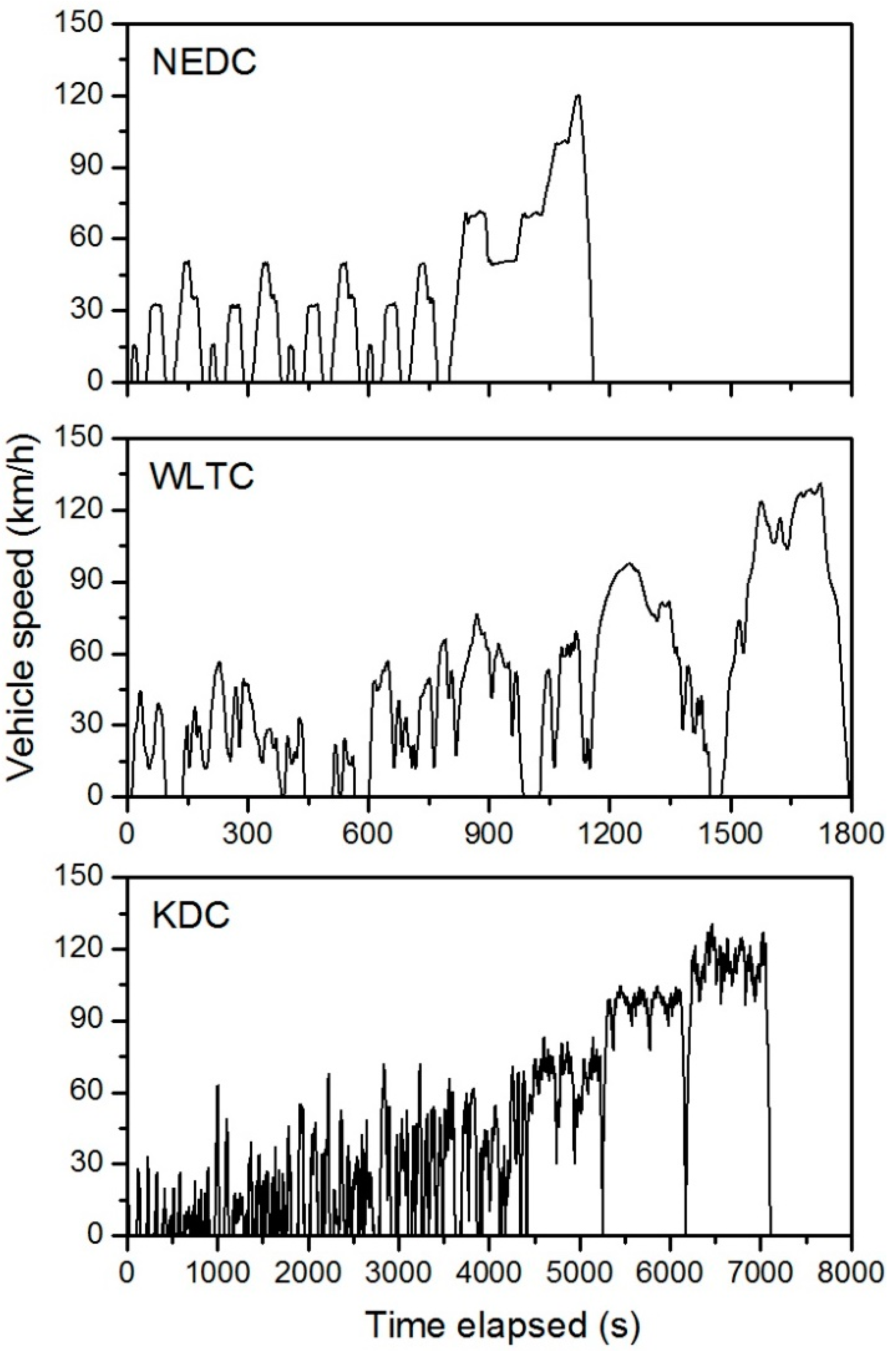
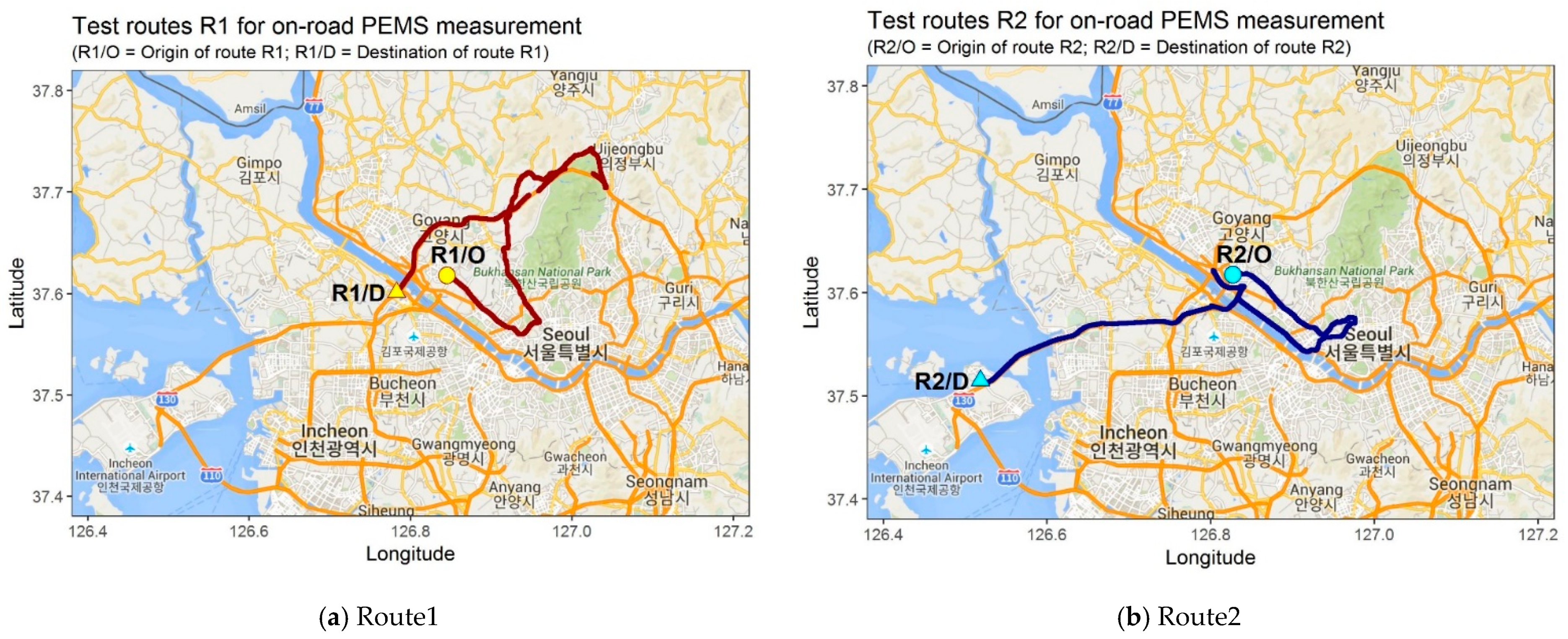
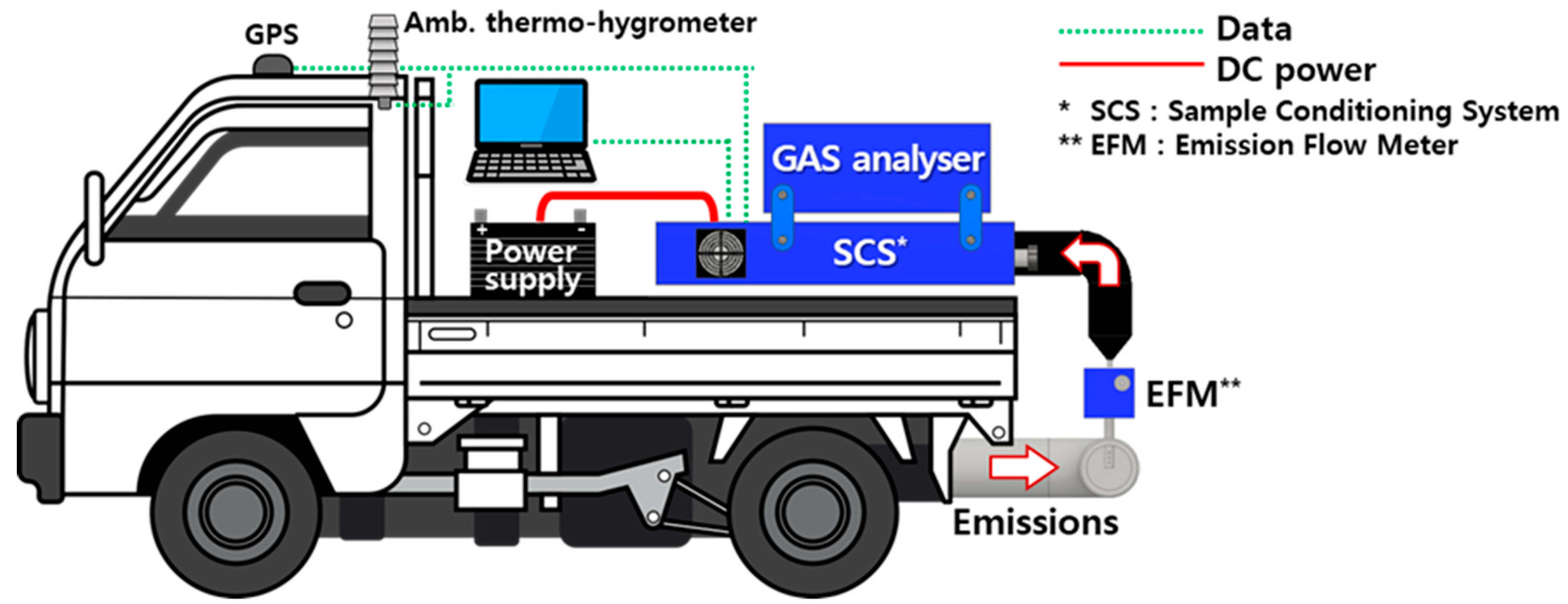


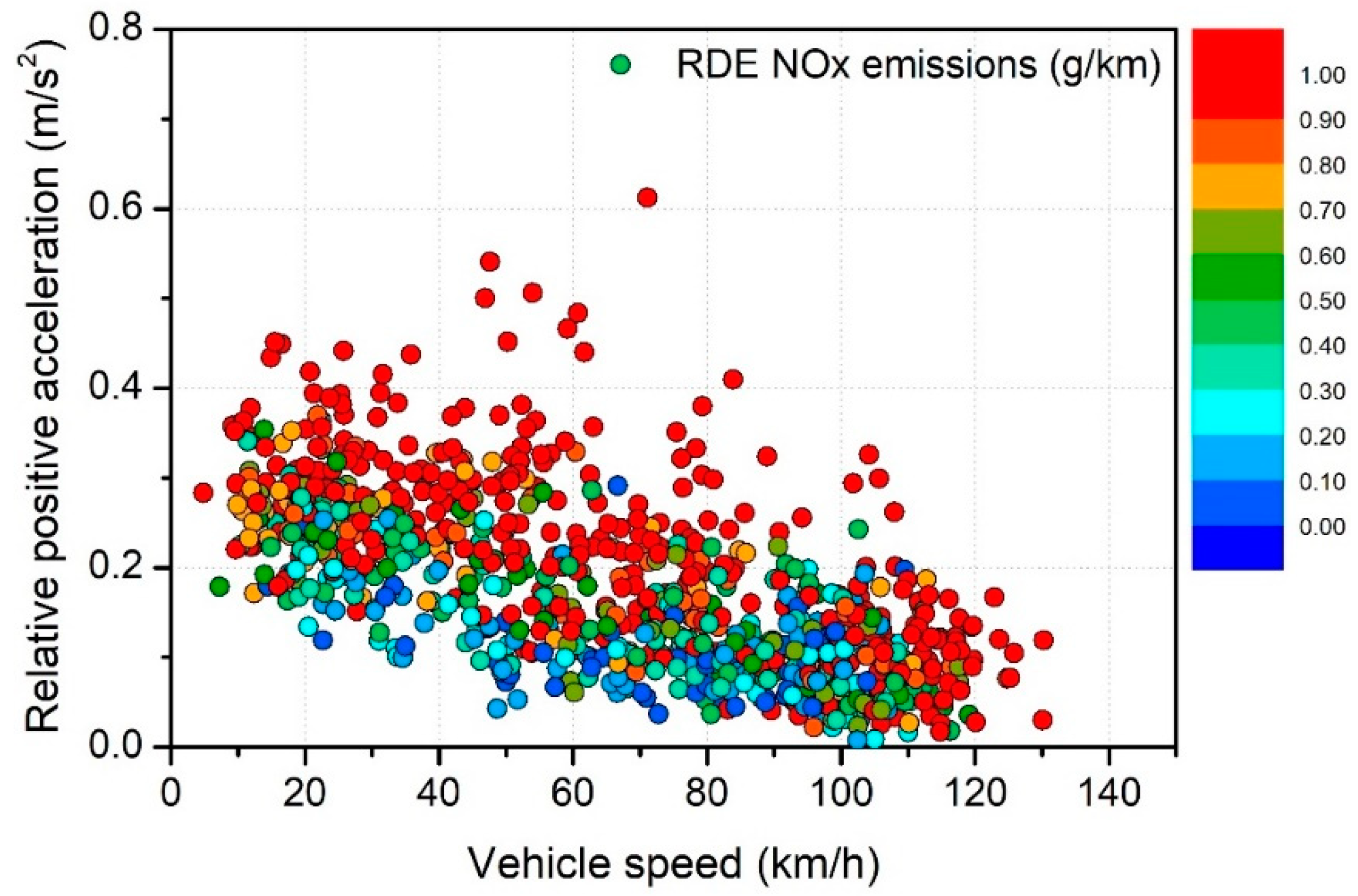
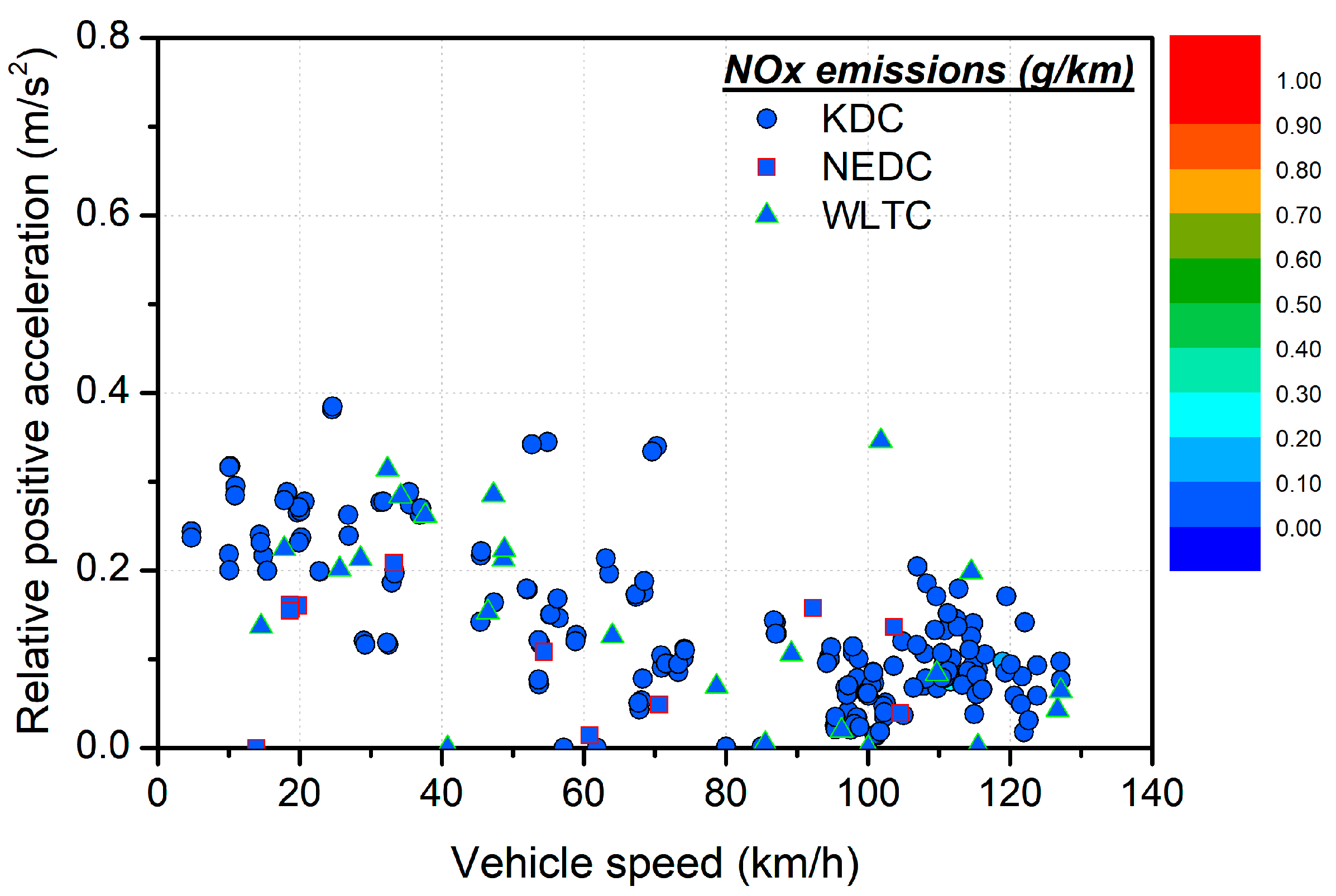
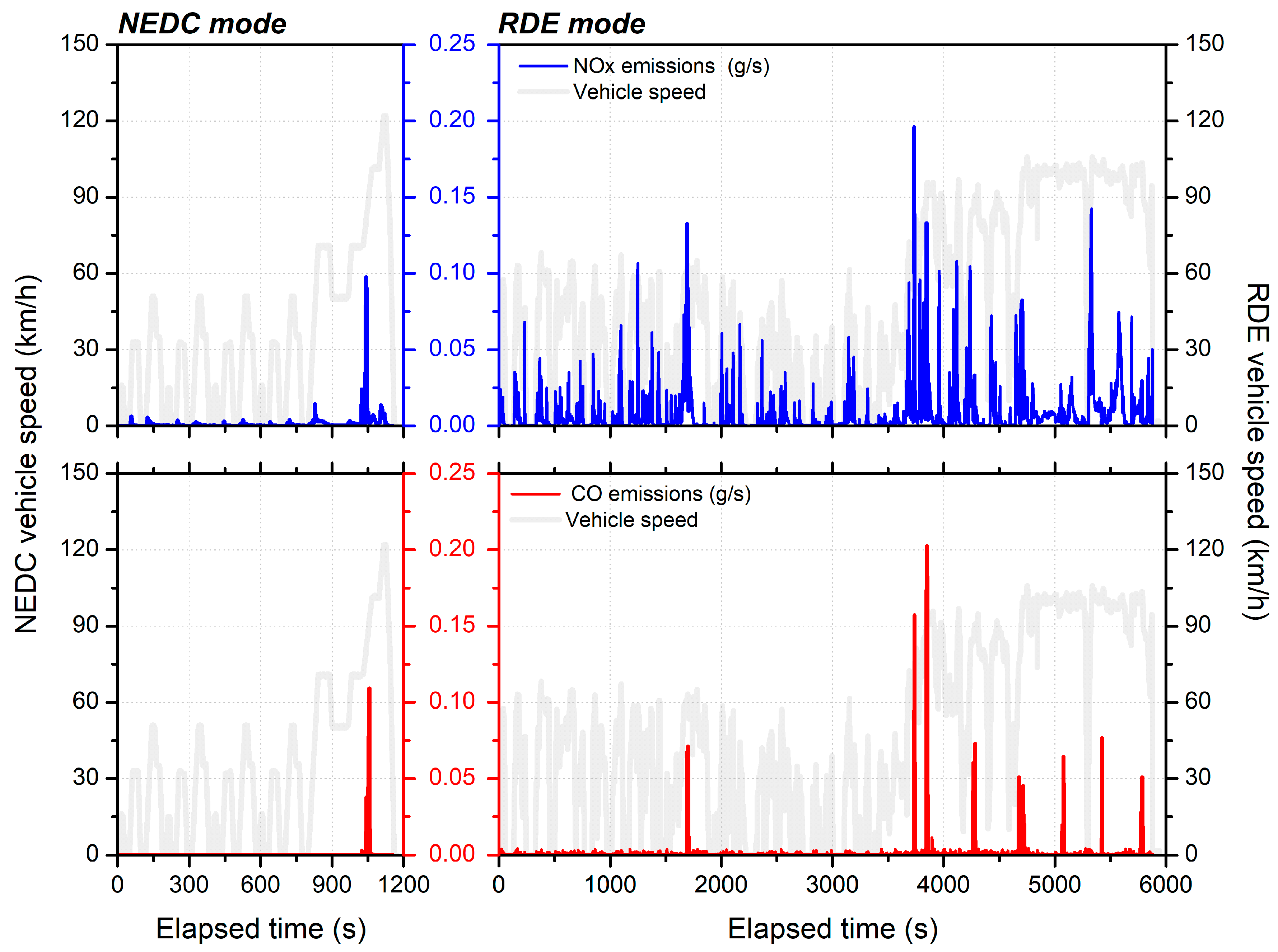

| Vehicle ID | Transmission | Emission Standard | Engine Volume(L) | Model Year | Mileage (km) | Emission Control System |
|---|---|---|---|---|---|---|
| V1 | Automatic | Euro 6b | 2.2 | 2018 | 6913 | EGR 1 DOC 2 LNT 3 DPF 4 |
| V2 | Automatic | Euro 6b | 2.5 | 2018 | 49,492 | |
| V3 | Automatic | Euro 6b | 2.5 | 2018 | 341 | |
| V4 | Manual | Euro 6b | 2.5 | 2018 | 20,087 | |
| V5 | Manual | Euro 6b | 2.5 | 2018 | 14,839 |
| Driving Cycle/Route | Mileage (km) | Duration (min.) | Average Vehicle Speed (km/h) | Maximum Vehicle Speed (km/h) | Stop Percentage of Urban Driving (%) |
|---|---|---|---|---|---|
| NEDC | 11.0 | 19 | 33.4 | 120.1 | - |
| WLTC | 23.3 | 30 | 46.5 | 131.2 | - |
| KDC | 89.6 | 118 | 45.4 | 130.6 | - |
| Route1 | 73.8 | 110 | 40.3 | 123.5 | 32.7 |
| Route2 | 75.4 | 108 | 41.9 | 125.7 | 33.0 |
Publisher’s Note: MDPI stays neutral with regard to jurisdictional claims in published maps and institutional affiliations. |
© 2021 by the authors. Licensee MDPI, Basel, Switzerland. This article is an open access article distributed under the terms and conditions of the Creative Commons Attribution (CC BY) license (http://creativecommons.org/licenses/by/4.0/).
Share and Cite
Ro, S.; Park, J.; Shin, M.; Lee, J. Developing On-Road NOx Emission Factors for Euro 6b Light-Duty Diesel Trucks in Korean Driving Conditions. Energies 2021, 14, 1041. https://doi.org/10.3390/en14041041
Ro S, Park J, Shin M, Lee J. Developing On-Road NOx Emission Factors for Euro 6b Light-Duty Diesel Trucks in Korean Driving Conditions. Energies. 2021; 14(4):1041. https://doi.org/10.3390/en14041041
Chicago/Turabian StyleRo, Seungcheon, Junhong Park, Myunghwan Shin, and Jongtae Lee. 2021. "Developing On-Road NOx Emission Factors for Euro 6b Light-Duty Diesel Trucks in Korean Driving Conditions" Energies 14, no. 4: 1041. https://doi.org/10.3390/en14041041
APA StyleRo, S., Park, J., Shin, M., & Lee, J. (2021). Developing On-Road NOx Emission Factors for Euro 6b Light-Duty Diesel Trucks in Korean Driving Conditions. Energies, 14(4), 1041. https://doi.org/10.3390/en14041041





